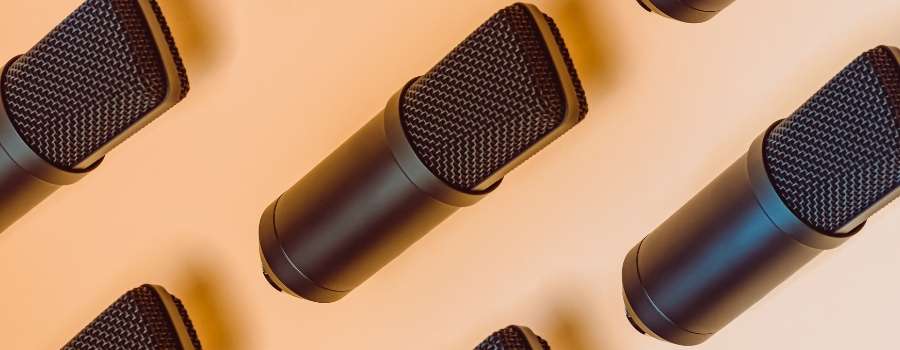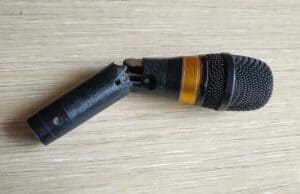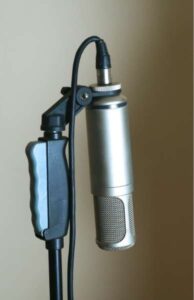
The reality of audio equipment is that microphones can go bad. There are many reasons why a microphone might stop working, so I wanted to look at some common causes and what you can do to avoid breaking your mic.
Since microphones are tools that will get used, they are going to wear out over time…and sometimes can deteriorate even if just sitting on a shelf for long periods of time.
Can Microphones Wear Out?
Like all audio equipment, microphones will start to deteriorate over time from normal usage. Wires can burn out and dust can build up inside of the windscreen which will damage the diaphragm causing it to not resonate as normal.
The biggest problem with the deterioration is that you won’t even be aware of it. You might think that your microphone is functioning properly and it’s just not.
You’ll know when the time has come to get a new mic if you notice any of these signs:
- Your voice sounds different like you’re talking too loudly or softly.
- You can’t hear yourself over background noise as well as before.
- The sound quality is worse than before.
What Can Cause A Microphone To Break?
Microphones normally get damaged from being dropped but can also be damaged by other factors such as heat damage, water damage, or power surges.
There are many reasons why a microphone might stop working. Here’s a list of some of the most common causes:

- Drops
- Wires/Cables Breaking
- Dust, Dirt, and Grime
- Condenser Is Damaged
- Power Surge/Electrical Problems
- Water/Humidity
Drops
Drops are the most common cause of microphone failure. This is especially true for those who go out with their equipment and put it on a stand that’s not stable enough to hold weight. The mic will get knocked off and when you pick it up again, it will be broken.
If you’re going to go out and use your microphone, make sure that the stand is strong enough for its weight and get a shock mount if possible so that the mic isn’t getting knocked around when not in use.
Wires/Cables Breaking
Wires can break or get caught in something which will damage that wire and prevent it from transmitting sound.
If you frequently switch between a wireless and wired microphone, you may forget that you are plugged in and try to walk beyond the length of the cable. When you do this, the wire can break or come loose inside of the insulated cable…or the whole microphone can pull from your hand and fly across the floor.
Dust, Dirt, and Grime
Dust builds up on windscreens over time and will eventually make its way inside the microphone and start to build upon the diaphragm, preventing it from resonating as it should.
The best way to prevent this is by taking the time, every few months, to clean your microphone. The process usually takes less than five minutes and can be done with a vacuum cleaner tube or brush and a few light blasts of canned air.
Condenser Is Damaged
A condenser is a diaphragm that is located inside of a microphone that will help pick up sound vibrations from the air.
The condenser is sensitive to heat and dampness, so if you leave your mic in a car or put it close to humidity sources like bathrooms or showers, then this will cause the diaphragm inside of the microphone to break down over time.
When a condenser microphone is damaged, it produces low-quality output and interference with other instruments when you’re trying to use it on stage or in an amplified setting.
The best way to prevent this is by keeping your equipment in a dry and cool place and try to use storage cases when possible.
Power Surge/Electrical Problems
Having a power surge can also damage microphones. The electronics inside of the microphone can be shorted out or fried and will stop working properly.
This is another reason why you should keep your equipment in a dry, cool place instead of leaving it on top of an amplifier or other device that has electric components themselves.
It may be overkill, but storing your microphones in a shock proof case will protect them from just about anything.
Water/Humidity
If there’s water nearby like near a shower or kitchen sink, then the microphone can easily pick up that moisture and start to corrode or increase the likelihood of electrical shorts.
Most microphones will have a light that turns on when this happens, but if not then you might want to have a humidity tester…called a hygrometer…in the room where you store your microphones and other audio equipment. If you notice that the room has a high amount of moisture in the air then you will want to consider a dehumidifier.
How Long Should A Microphone Last?
Typically, a microphone has a lifespan between five to ten years. However, higher-quality microphones that get regular maintenance and are handled with care can last 30 years or more.
An inexpensive microphone…say one you’d use for traveling gigs, is going to last anywhere between a few years to about a decade. These mics are probably not going to come with hard cases and will likely get knocked around a lot when you take them to gigs.
A high-end microphone, like a Neumann, isn’t likely going to be the mic your throw in your gig bag when you hit the road. These mics are usually constructed with better materials and with higher attention to detail meaning they’re built to last longer.
Most people are going to baby their high-end gear so they are going to get the nicer cases, only be used for in-house recording gigs, and get regular maintenance check-ups.
Is It Okay To Leave A Microphone Plugged In?
Leaving a microphone plugged in for long periods of time can cause the device to fall from the stand or roll off a table, and also degrade delicate parts since it may be exposed to humidity, smoke, and sunlight.

Leaving microphones plugged in can come with a lot of headaches down the line:
- Tripping hazards from the cables.
- Degraded sound quality is caused by not using the cables for a long period of time.
- Damaged cable connectors when someone trips on them or they’re pulled during use.
- Exposing your microphones to moisture and humidity.
- Electrical shorts if there are any exposed wires near water sources like a sink or another water source.
- Feedback from other equipment.
Can Feedback Damage A Microphone?
Typically, feedback won’t damage a microphone unless the noise threshold surpasses the microphone’s Sound Pressure Level (SPL) which can be up to 144dB. Feedback will hurt your ears more than it will hurt your microphone.
Here is a chart showing some popular microphones and their SPL rating:
| Microphone | SPL |
| Neumann TLM 102 | 144dB |
| Shure SM58 | 94dB |
| Rode NT1-A | 137dB |
| Aston Origin | 127dB SPL |
| AKG C214 | 136dB |
Feedback happens when a microphone gets too close to other microphones or speakers in your environment and captures feedback from itself, causing an annoying screech.
If you’re using multiple mics at once and they get too close then it’s possible that the electronic device will amplify this sound and cause feedback.
Remember, if your mic starts screeching during use then stop and find out why. Luckily, feedback is usually a “quick-fix,” and while it likely won’t destroy your microphone it can be horrible for your ears.
How Do I Know If My Microphone Is Broken?
Ideally, you’ll want a baseline idea of how your microphone sounds and then spot-check your microphone against this baseline each time you plan to use it. Listen for any anomalies to the sound like pops, hisses, or feedback.
If you’ve noticed a change in your microphone’s sound quality or if you notice any issues with how it functions during use then it may be broken and should be evaluated by an expert for repair before it can be used again.
How Do I Troubleshoot A Microphone That Sounds Bad?
When troubleshooting, make sure there is no obvious damage to the body of the microphone or cables running to it. Always start with the easiest thing to replace first, the cables, then the windscreen, etc.
You should troubleshoot your microphone the same way you should troubleshoot any piece of equipment, by checking the obvious things first. If you plug a mic in and get audio anomalies, then first try a different cable…then check the connection ends
Another good rule of thumb is to regularly PM (preventative maintenance) your microphones. Have a regular schedule where you plug in and test all of your audio equipment.
As you purchase new equipment, a great idea is to make a test recording of how the equipment sounds…or use reference tracks from the manufacturer or YouTube. use these reference tracks when you do your PMs or when you think you might have a microphone that you think might have issues.

